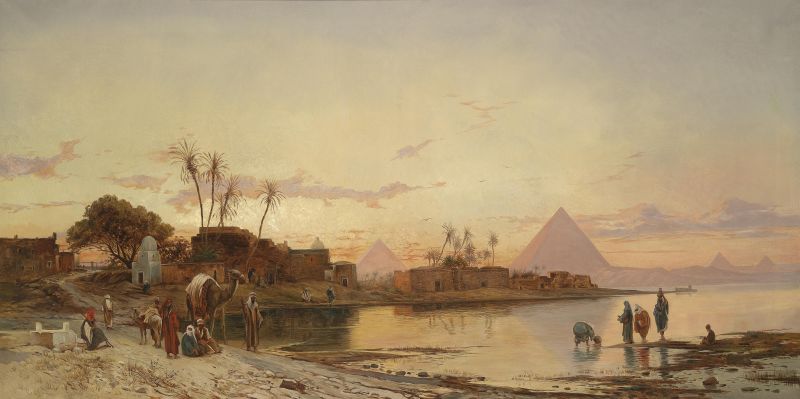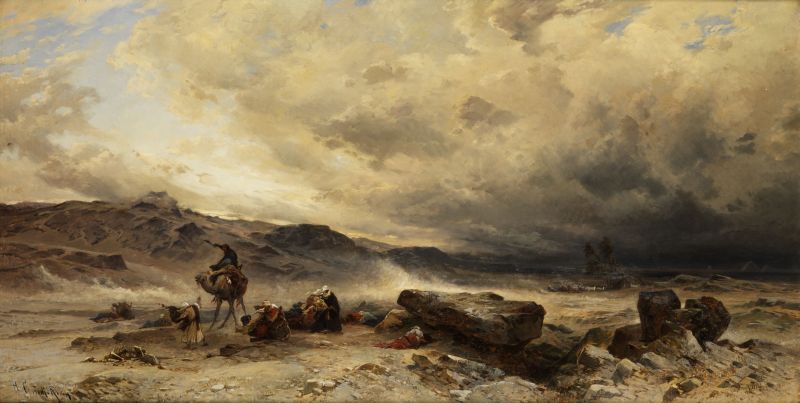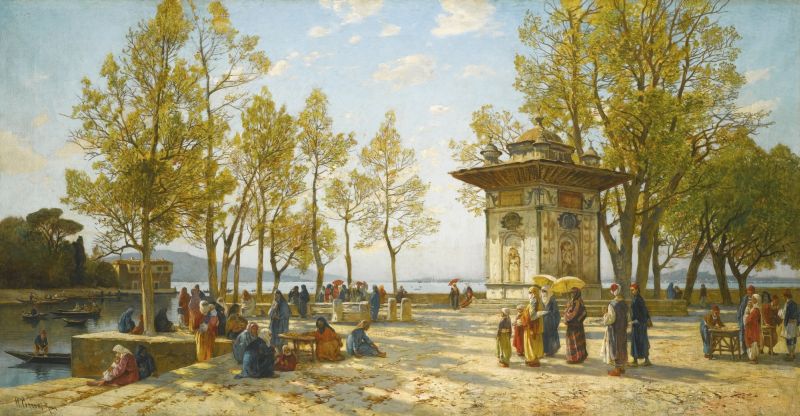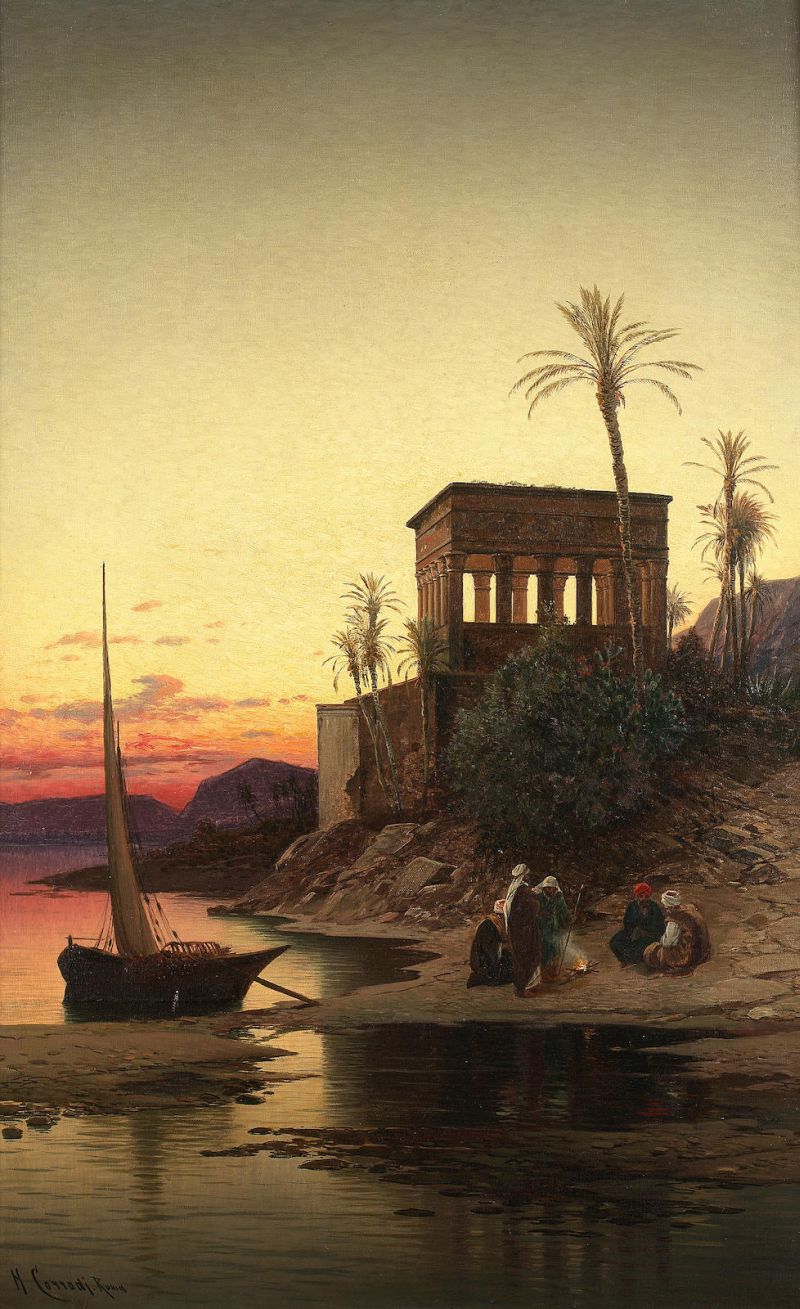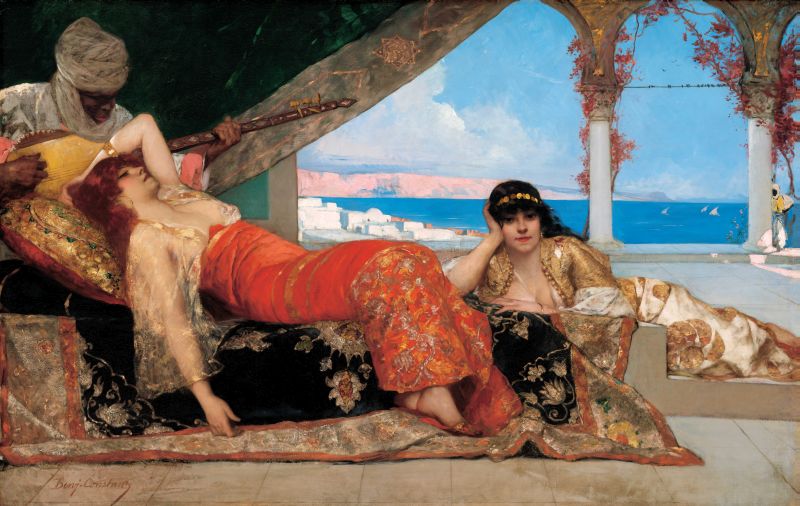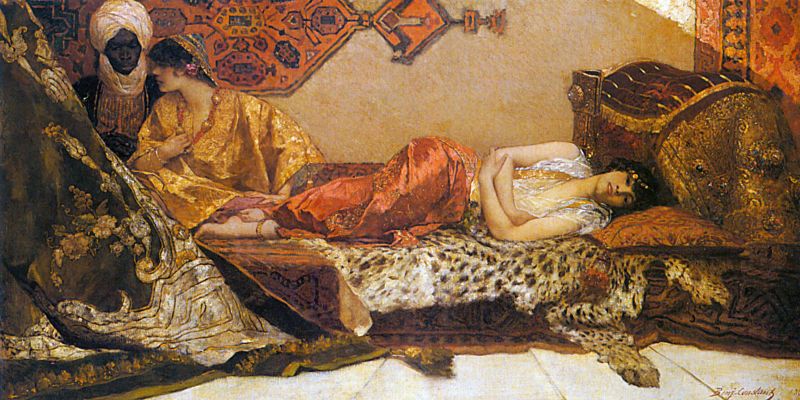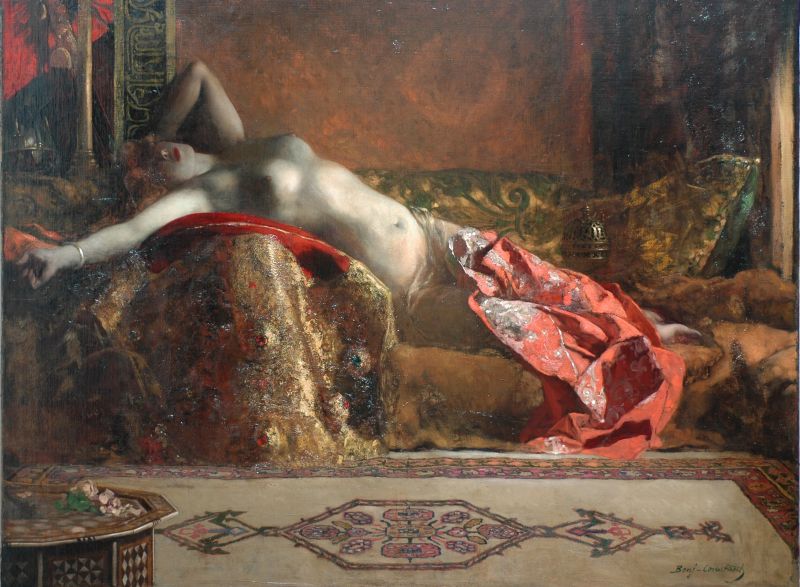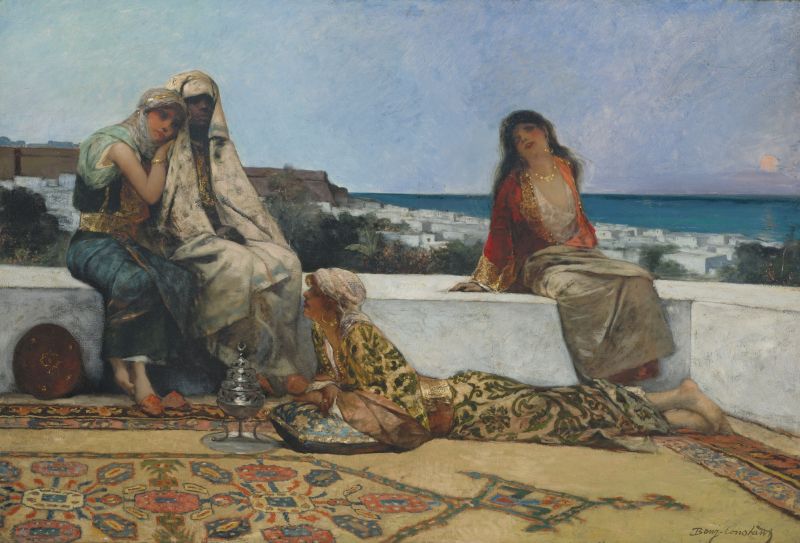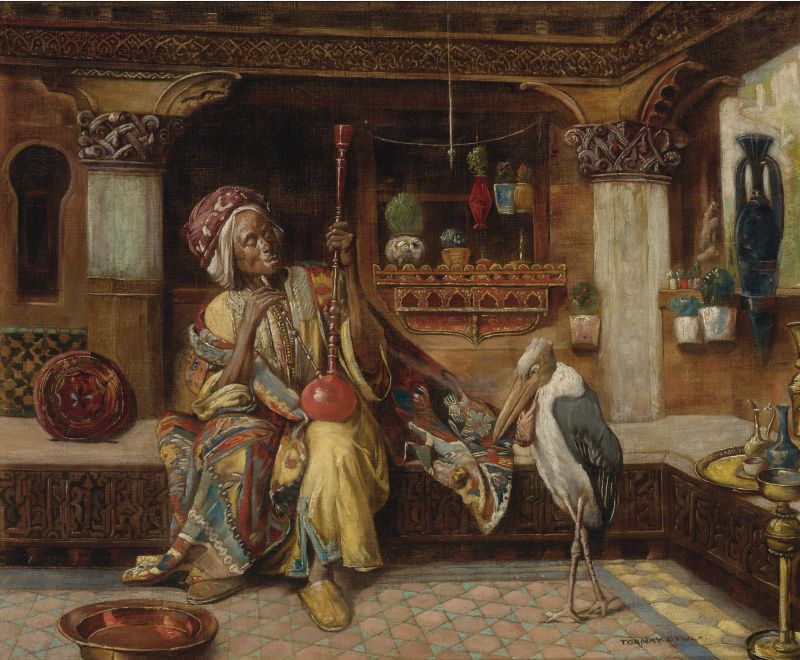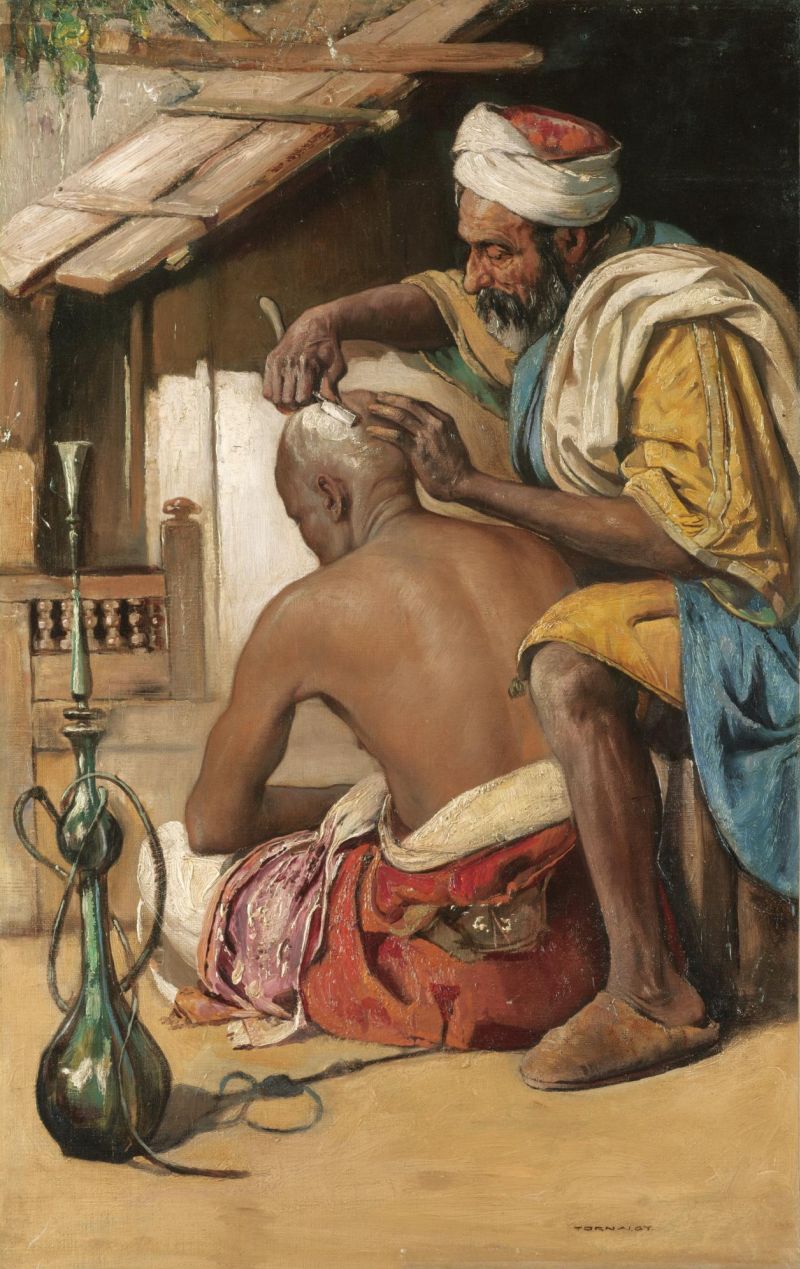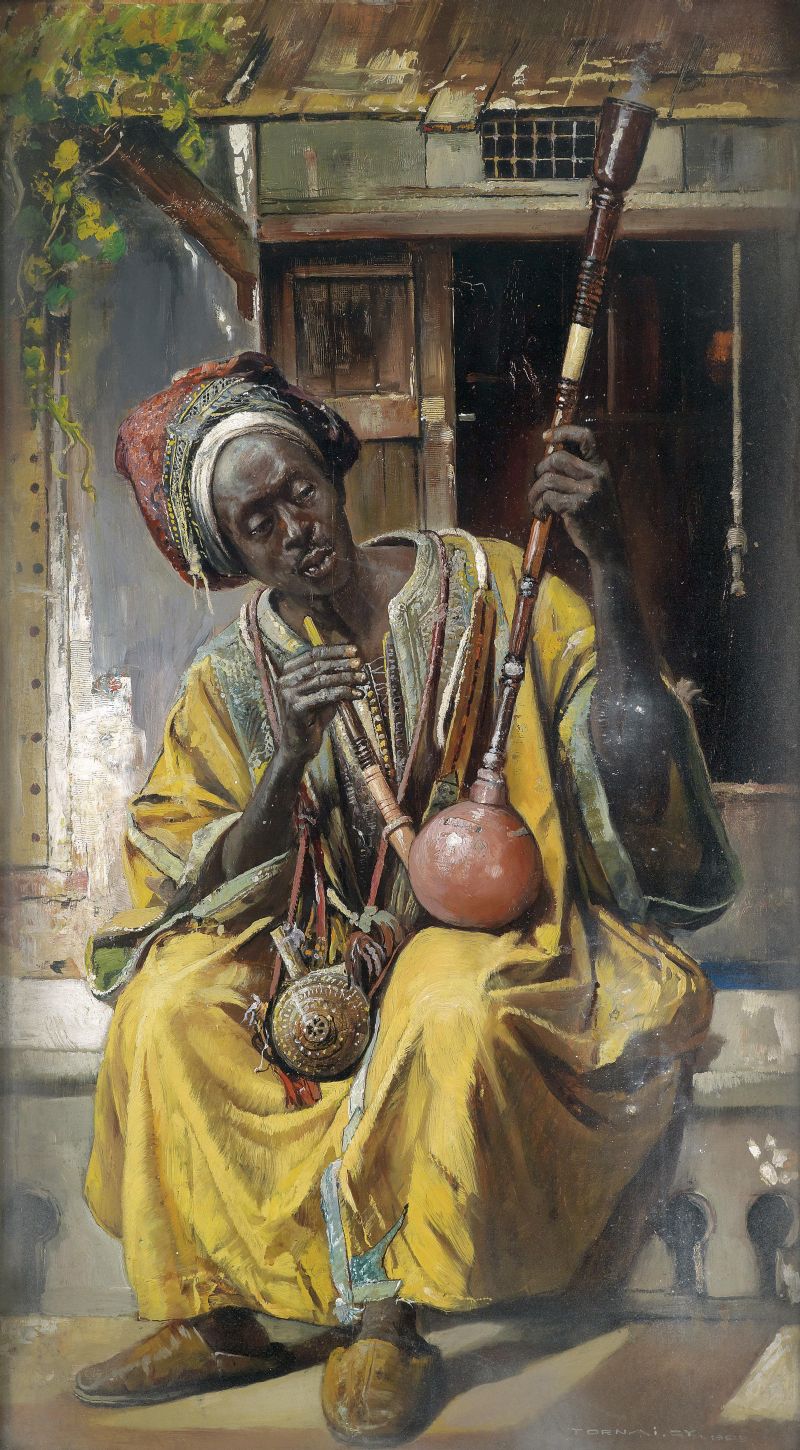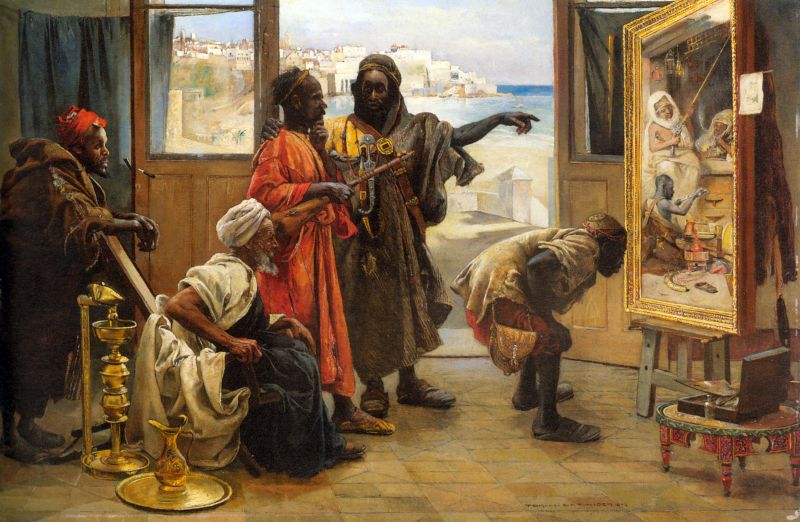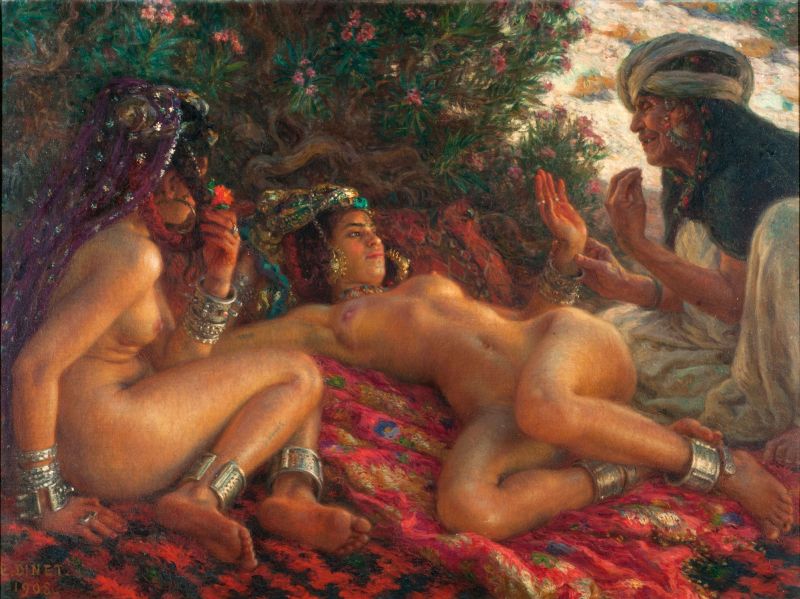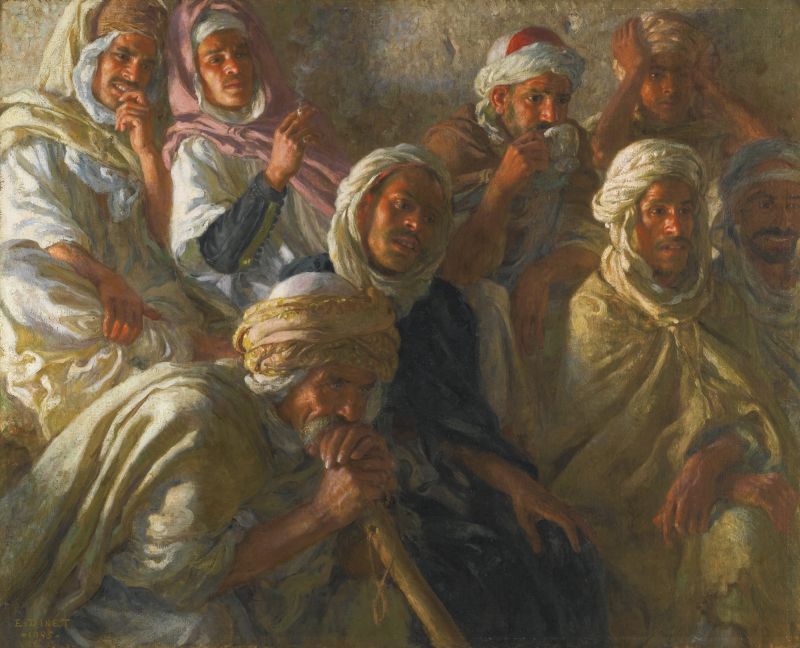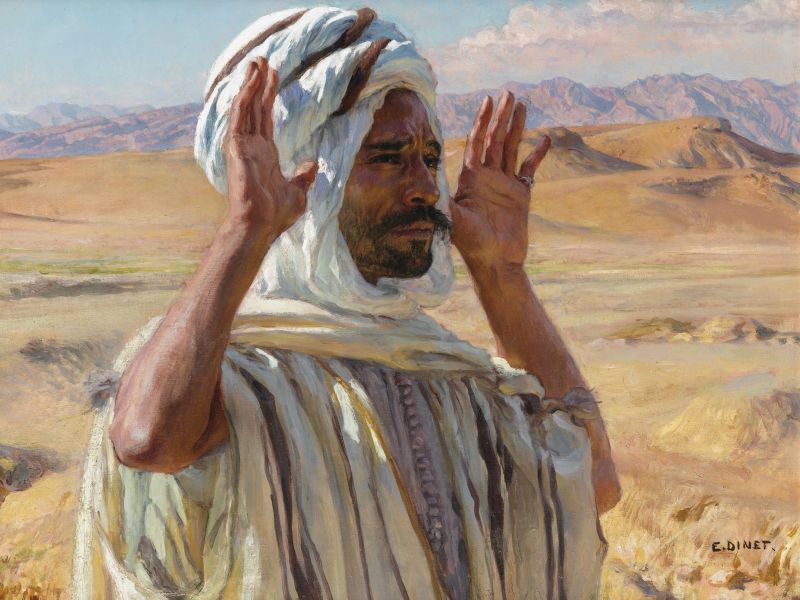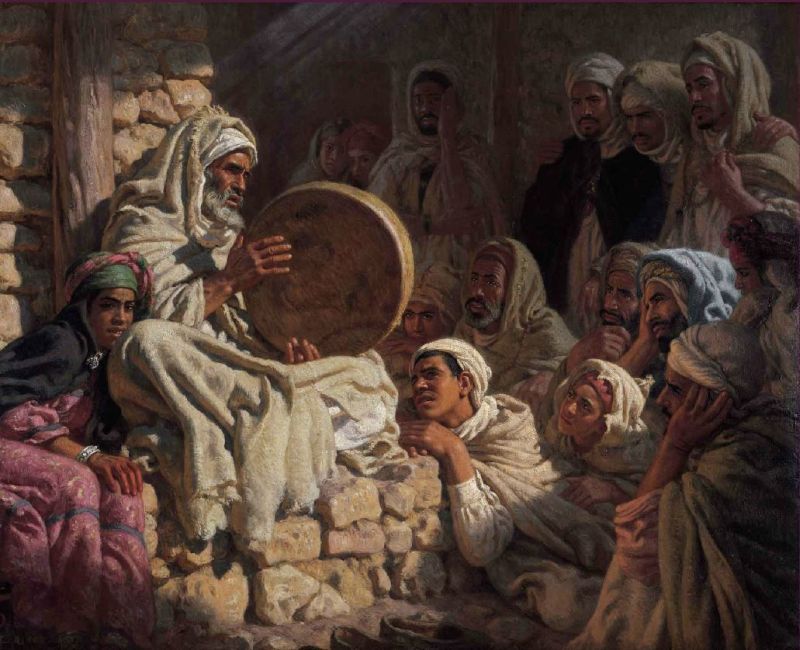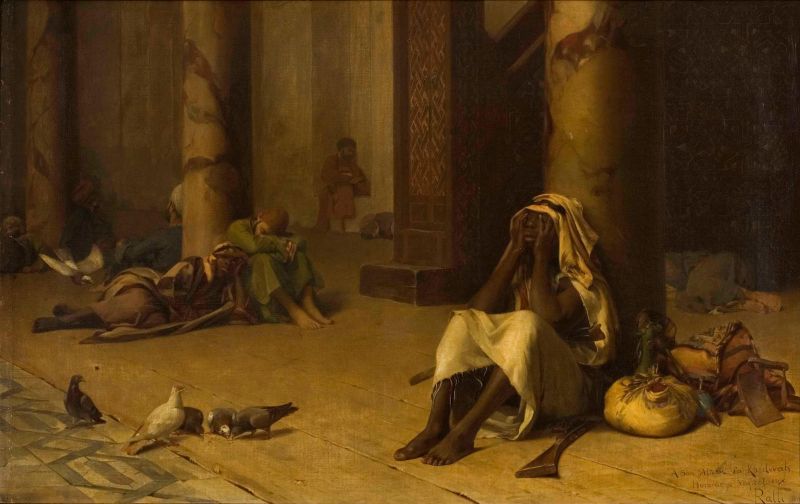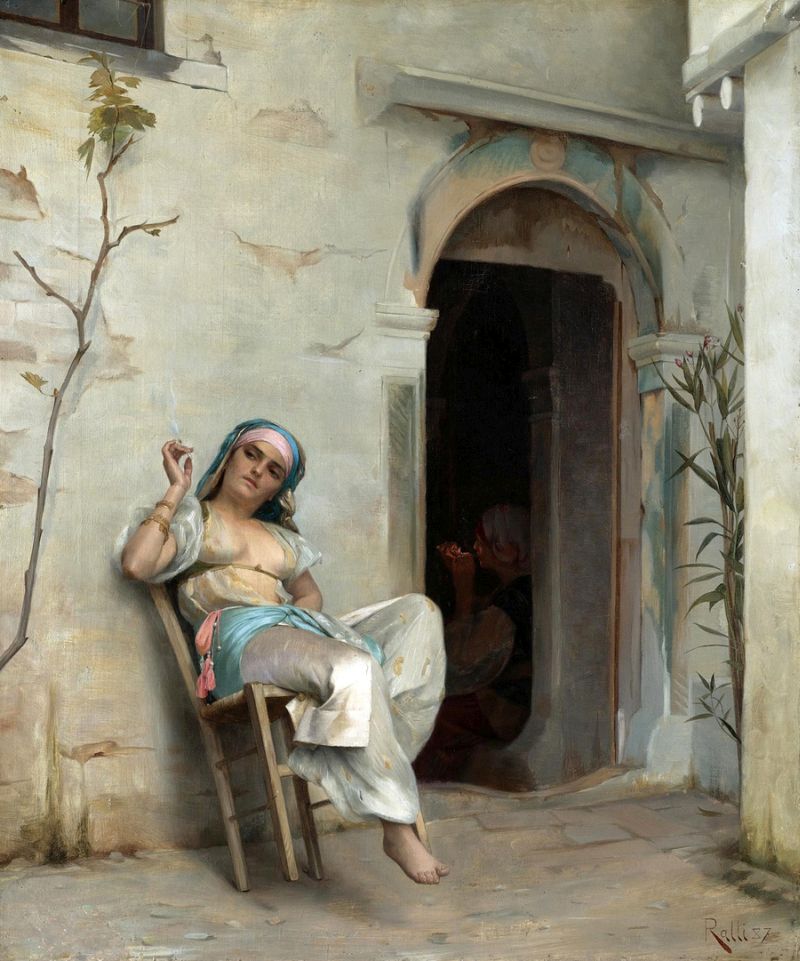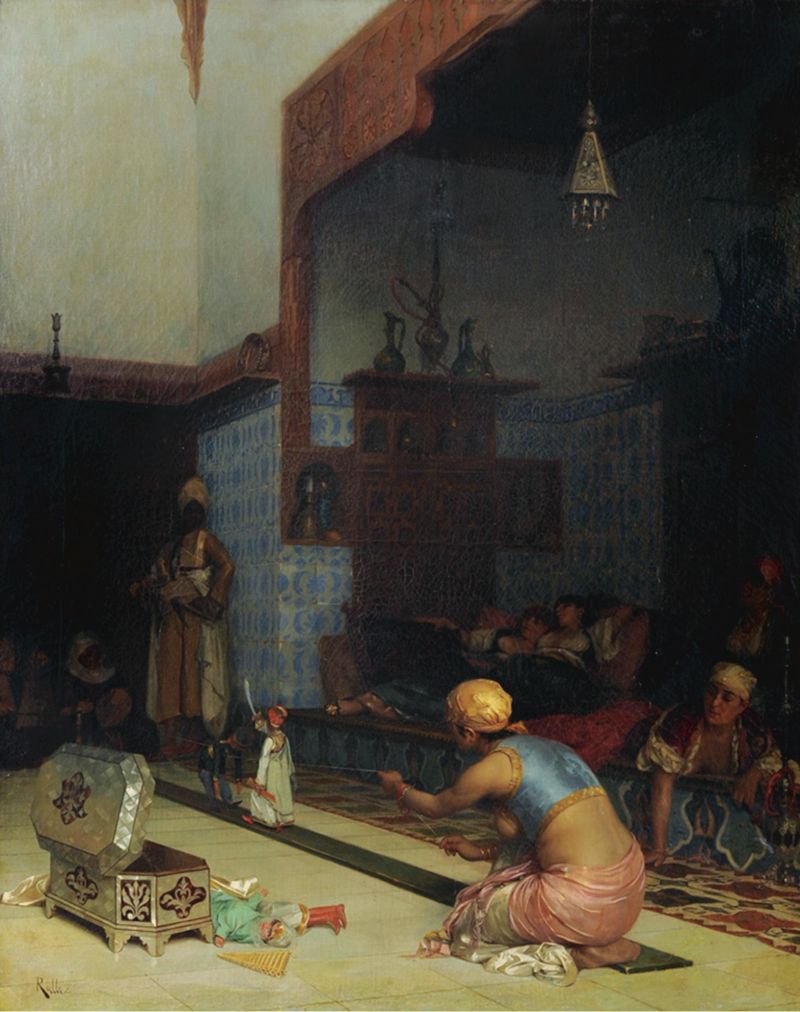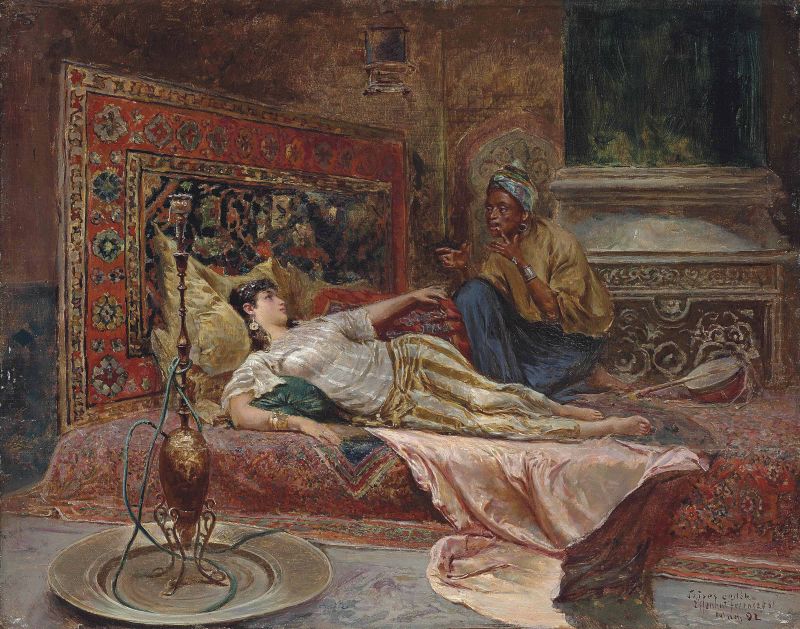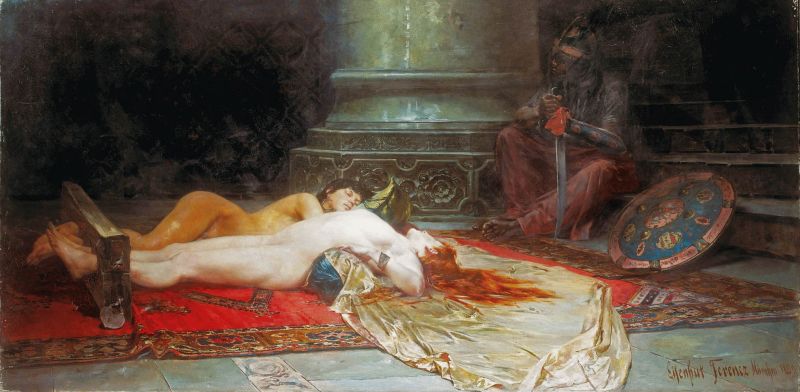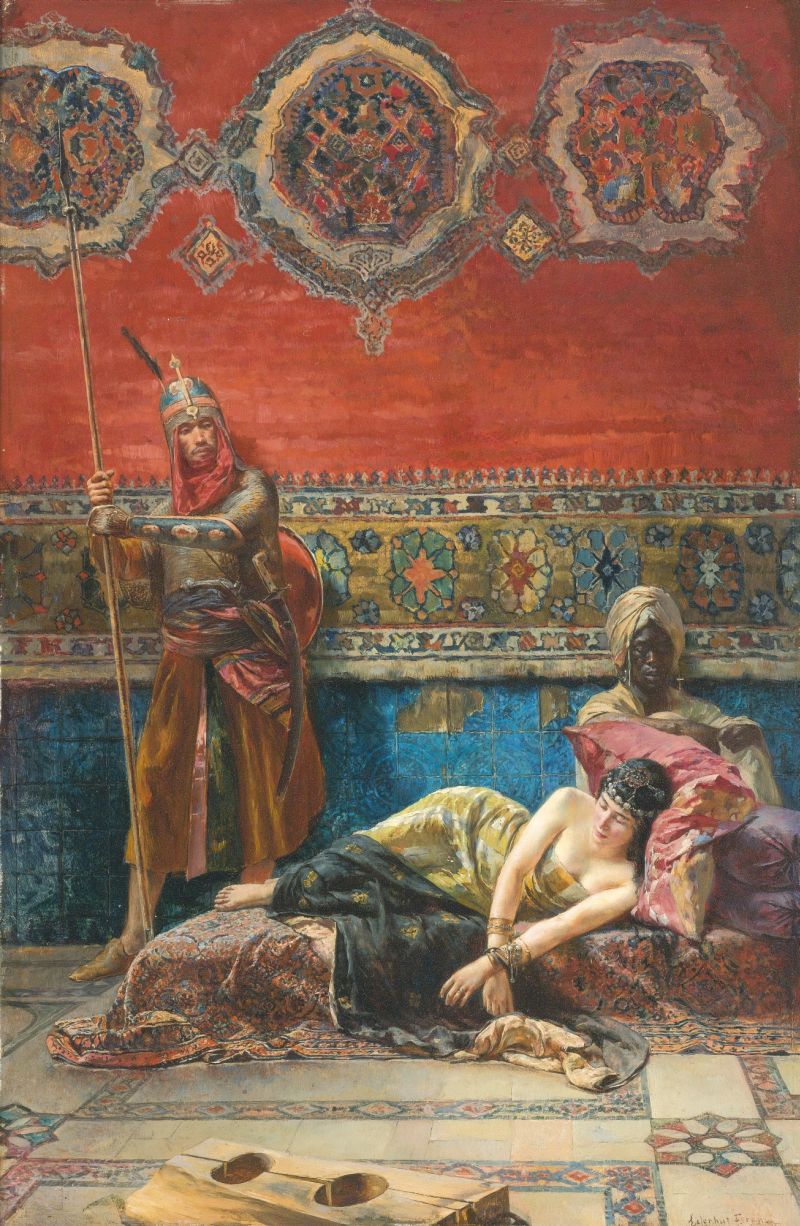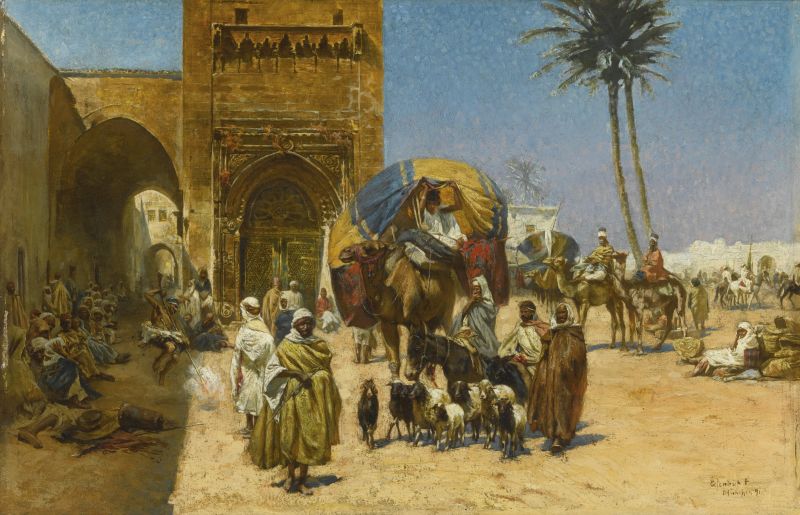Hermann David Salomon Corrodi
(Frascati, Italia / Italy, 1844 - Roma / Rome, 1805)
"En los bancos del Nilo / At the Nile Bank"
Óleo sobre lienzo / oil on canvas, 84 x 164,5 cm., c.1905. Wikimedia Commons
Hermann David Salomon Corrodi fue un pintor italiano de paisajes y escenas orientalistas nacido en 1844 en Frascati (una fuente alternativa cita su lugar de nacimiento como Zurich), y fallecido en 1905.
Más imágenes e información en el post previo.
Más imágenes e información en el post previo.
"Caravan in una tempesta di sabbia / Caravana en una tormenta de arena / Caravan in a Sandstorm"
Óleo sobre lienzo / oil on canvas, 65,5 x 127 cm. Hampel
"La fontana delle acque dolci dell'Asia, sul Bosforo / La fuente de agua dulce de Asia, sobre el Bósforo /
The Fountain of the Fresh Water of Asia, on the Bosphorus"
Óleo sobre lienzo / oil on canvas, 86,5 x 165 cm. Sotheby's
Hermann David Salomon Corrodi was an Italian painter of landscapes and orientalist scenes born 1844 in Frascati (an alternate source lists his birthplace as Zurich). He died in 1905.
More images and information in previous post.
More images and information in previous post.
"El quiosco de Trajano, Filae en el Nilo / The kiosk of Trajan, Philae on the Nile"
Óleo sobre lienzo / oil on canvas, 102 x 64,5 cm. Bonhams
Hermann Corrodi en "El Hurgador" / in this blog: [Aniversarios (CCXXXIX)]
______________________________________________________
Jean-Joseph Constant (Benjamin-Constant)
(París, Francia / France, 1845 - 1902)
"La favorita del emir / The Favorite of the Emir", óleo sobre lienzo / oil on canvas, 142,2 x 221 cm., 1879
National Gallery of Art (Washington, EE.UU./ USA)
Jean-Joseph Benjamin-Constant (también conocido como Benjamin Constant) fue un pintor y grabador francés nacido en 1845 en París, conocido por sus temas y retratos orientalistas.
Estudió en la Ecole des Beaux-Arts en Toulouse, donde fue alumno de Alexandre Cabanel. Un viaje a Marruecos en 1872 influyó fuertemente en su temprano desarrollo artístico y lo llevó a producir escenas románticas bajo el hechizo del orientalismo. Entre sus obras más destacadas en este sentido están"Los últimos rebeldes", "Justicia en el harén" (ambas en la Galería de Luxemburgo), "Les Chérifas" y "Prisioneros marroquíes" (Burdeos). Su gran lienzo, "La entrada de Mahoma II en Constantinopla" (Museo de los Agustinos de Toulouse), recibió una medalla en 1876.
Después de 1880, cambió su estilo, dedicándose a decoraciones murales y retratos. Ejemplos destacados incluyen el gran plafond en el Hôtel de Ville, París, titulado "Paris Convocando al mundo", sus pinturas en la Nueva Sorbona, que representan la literatura, las ciencias y la Academia de París, y el plafond del teatro Opéra Comique. Destacó como pintor de retratos, especialmente en Inglaterra, donde era un favorito de la aristocracia. Su retrato "Mi hijo André" (Luxemburgo) fue galardonado con una medalla de honor en el Salón en 1896.
Pintó al Papa León XIII, a la Reina Alexandra del Reino Unido (1901), a Lord John Lumley-Savile y a Henri Blowitz (1902). Fue nombrado miembro del Instituto en 1893 y comandante de la Legión de Honor. Visitó los Estados Unidos varias veces y pintó varios retratos. El Museo Metropolitano de Arte de Nueva York posee una gran decoración mural de Benjamin-Constant titulada "Justiniano en Consejo".
También enseñó, y entre sus alumnos estuvo la miniaturista Alice Beckington. Fue un escritor de renombre, contribuyendo con una serie de estudios sobre pintores franceses contemporáneos. Junto con otros artistas, Nasreddine Dinet, Paul Leroy, Jean-Léon Gérôme y el curador / historiador de arte, Léonce Bénédite, fue uno de los fundadores de la Société des Peintres Orientalistes Français.
Murió en 1902.
"La odalisca / The Odalisque", óleo sobre lienzo / oil on canvas, 109 x 211 cm., 1882. Wikimedia Commons
"Odalisca reclinada / Reclining Odalisque"
Óleo sobre lienzo / oil on canvas, 115 x 149 cm., c.1870
Colección / Collection Ger Eenens (Holanda / Netherlands). Wikimedia Commons
Jean-Joseph Benjamin-Constant (also known as Benjamin Constant) was a French painter and etcher born in 1845 in Paris, best known for his Orientalist subjects and portraits.
He studied at the Ecole des Beaux-Arts in Toulouse, where he was a pupil of Alexandre Cabanel. A journey to Morocco in 1872 strongly influenced his early artistic development and lead him to produce Romantic scenes under the spell of Orientalism. Among his noted works in this vein are Last Rebels, Justice in the Harem (both in the Luxembourg Gallery), Les Chérifas, and Moroccan Prisoners (Bordeaux). His large canvas, The Entrance of Mahomet II into Constantinople (Musée des Augustins Toulouse), received a medal in 1876.
After 1880, he changed his manner, devoting himself to mural decorations and to portraits. Prominent examples include the great plafond in the Hôtel de Ville, Paris, entitled Paris Convening the World; his paintings in the New Sorbonne, representing Literature, The Sciences, and the Academy of Paris; and the plafond of the Opéra Comique theatre. He was distinguished as a portrait painter, especially in England, where he was a favorite of the aristocracy. His portrait Mon fils André (Luxembourg) was awarded a medal of honor at the Salon in 1896.
Benjamin-Constant painted Pope Leo XIII, Queen Alexandra of the United Kingdom (1901), Lord John Lumley-Savile, and Henri Blowitz (1902). He was made a member of the Institute in 1893, and was a commander of the Legion of Honor. He visited the United States several times, and painted a number of portraits. The Metropolitan Museum of Art in New York owns a large mural decoration by Benjamin-Constant entitled Justinian in Council.
Benjamin-Constant also taught; among his pupils was the miniaturist Alice Beckington. He was a writer of repute, contributing a number of studies on contemporary French painters. Along with fellow artists, Nasreddine Dinet, Paul Leroy, Jean-Léon Gérôme and curator/ art historian, Léonce Bénédite, he was one of the founders of the Société des Peintres Orientalistes Français.
He died in 1902.
"Horas del crepúsculo / Twilight Hours", óleo sobre lienzo / oil on canvas, 102,2 x 151,1 cm. Sotheby's
Jean-Joseph Benjamin-Constant en "El Hurgador" / in this blog: [Manos a la obra (XXV)]
______________________________________________________
Gyula Tornai
(Görgö, Hungría / Hungary, 1861 - Budapest, 1928)
"Fumador con narguile y marabú / Smoker With Hookah and Marabou"
Óleo sobre lienzo / oil on canvas, 58,4 x 69,9 cm. Sotheby's
Gyula Tornai fue un pintor húngaro nacido en 1861 en Görgö.
Recibió su educación artística en academias en Viena, Munich y en los estudios de Benczúr en Budapest, donde estudió con Hans Makart y Gyula Benczúr. Sus primeras pinturas fueron imágenes de temas cotidianos populares. Su estilo fue fuertemente influenciado por Makart.
Después de sus viajes a España, Argelia y Marruecos, recurrió a temas más exóticos y pintó obras que representan la vida en la calle, mercaderes, músicos y harenes. Pasó 10 años en Marruecos y vivió en Tánger durante un año entre 1890 y 1891. En 1900 exhibió fotos en la Exposición Universal de París con gran aclamación, ganando la medalla de bronce. En 1904 vendió muchas de sus obras para recaudar dinero para seguir viajando.
En el verano de 1905 viajó al Lejano Oriente donde continuó su interés en temas orientalistas, recorriendo la India y Japón. Poco después de su llegada a este país, pintó un retrato del ex primer ministro, el conde Okuma, que se convirtió en un patrón influyente para él. Este mecenazgo le dio un acceso sin precedentes a muchas facetas de la vida y las costumbres japonesas que previamente habían estado ocultas a los europeos. Esto le permitió explorar el budismo y el sintoísmo en profundidad. Tornai permaneció en Japón durante 16 meses, tiempo durante el cual pintó obras como "Princesa japonesa yendo a la iglesia", "Geisha", "La casa de la Geisha" y "Guerrero samurai", entre otras.
En 1907 exhibió en París y Londres, en 1909 en Budapest en el Műcsarnok y en 1917 en el Salón Nacional.
Sus trabajos orientalistas le ganaron reconocimiento internacional en vida. Una fuente contemporánea comentó que sus obras de este período, "por su glorioso colorido y la intensa apreciación del pintoresco oriente, no se habían visto antes". Sus pinturas también se caracterizan por su ironía, humor y ingenio. Por ejemplo, su pintura "Los entendidos" presenta a un grupo de lugareños, posiblemente bereberes, reunidos en el estudio del artista examinando críticamente una pintura de hombres orientales. Estos hombres probablemente fueron el tema de la pintura. También le dio a los espectadores vislumbres de otro mundo con sus representaciones de costumbres y prácticas orientales. Varias de las pinturas de Tornai se conservan en la Galería Nacional Húngara.
Murió en 1928.
"El barbero / The Barber", óleo sobre lienzo / oil on canvas, 68,5 x 44 cm. Sotheby's
"El fumador de pipa de agua / The Water-Pipe Smoker"
Óleo sobre panel / oil on panel, 58 x 34 cm., 1903. Wikimedia Commons
Gyula Tornai was a Hungarian painter born in 1861 in Görgö.
He received his art education at academies in Vienna, Munich and at Benczúr's Studios in Budapest where he studied under Hans Makart and Gyula Benczúr. His initial paintings were pictures of popular everyday themes. His style was heavily influenced by Makart.
Following his travels to Spain, Algeria and Morocco, he turned to more exotic themes and painted works depicting street life, merchants, musicians and harems. He spent 10 years in Morocco and lived in Tangiers for a year between 1890 and 1891. In 1900, he exhibited pictures in the Exposition Universelle in Paris to great acclaim, winning the bronze medal. In 1904, he sold many of his works to raise money for further travel.
In the Summer of 1905, he travelled to Far-East where he continued his interest in Orientalist themes. During this period he travelled through India and Japan. Shortly after his arrival in Japan, he painted a portrait of the former Prime-Minister, Count Okuma, who became an influential patron. This patronage gave him unprecedented access to many facets of Japanese life and customs that had previously been hidden from Europeans. This allowed him to explore Buddhism and Shintoism in depth. Tornai remained in Japan for 16 months during which time he painted such works as A Japanese Princess Going to Church, Geisha, The Geisha House and the Samurai Warrior amongst other paintings.
In 1907 he was exhibited in Paris and London; in 1909 at Budapest in the Műcsarnok; in 1917 at the National Salon.
His Oriental works gained him international recognition during his own lifetime. A contemporary source commented that his works from this period, ”the like of which for glory of colour and intense appreciation of the picturesqueness of the east had not been seen before.” His paintings are also noted for their irony, humour and wit. For instance, his painting The Connoisseurs features a group of locals, possibly Berbers, gathered in the artist's studio critically examining a painting of Oriental men. These men were probably the subject of the painting. He also gave viewers glimpses of another world with his depictions of Oriental customs and practices. Several of Tornai's paintings are held in the Hungarian National Gallery.
He died in 1928.
"Los entendidos / The Connoisseurs", óleo sobre panel / oil on panel, 71,1 x 45,7 cm., 1892.
Colección privada / Private Collection. Wikimedia Commons
______________________________________________________
Alphonse-Etienne Dinet (Nasr'Eddine Dinet)
(París, Francia / France, 1861 - 1929)
"La mensajera de Satanás / The Messenger of Satan", óleo sobre lienzo / oil on canvas, 112 x 148 cm., 1908
Museo Nacional de Bellas Artes (Buenos Aires, Argentina)
Nasreddine Dinet, nacido Alphonse-Étienne Dinet en 1861 en París, fue un pintor orientalista francés. Quedó tan encantado con el norte de África y su cultura, que se convirtió al Islam y que dominaba el árabe. Además de sus pinturas, tradujo la literatura árabe al francés.
Desde 1871 estudió en el Lycée Henry IV, donde el futuro presidente Alexandre Millerand también estaba entre los estudiantes. Después de graduarse en 1881 se matriculó en la École nationale supérieure des Beaux-Arts y entró en el estudio de Victor Galland. Al año siguiente estudió con William Bouguereau y Tony Robert-Fleury en la Académie Julian. También expuso por primera vez en el Salon des artistes français.
Dinet hizo su primer viaje a Bou Saâda por el Ouled Naïl Range en el sur de Argelia en 1884, con un equipo de entomólogos. Al año siguiente hizo un segundo viaje con una beca del gobierno, esta vez a Laghouat. En ese momento pintó sus dos primeras imágenes argelinas: Les Terrasses de Laghouat y L'Oued M'Sila après l'orage.
Ganó la medalla de plata por una pintura en la Exposición Universal en 1889, y en el mismo año fundó la Société Nationale des Beaux-Arts junto con Meissonier, Puvis de Chavannes, Rodin, Carolus-Duran y Charles Cottet. En 1887 fundó con Léonce Bénédite, director del Musée du Luxembourg, la Société des Peintres Orientalistes Français.
En 1903 compró una casa en Bou Saâda y pasó tres cuartos de cada año allí. Dinet quedó tan encantado con el norte de África y su cultura, que finalmente se convirtió al Islam. Anunció su conversión al Islam en una carta privada de 1908, y la completó formalmente en 1913, después de lo cual cambió su nombre a Nasr'Eddine Dinet. En 1929, él y su esposa emprendieron la peregrinación a La Meca. En julio de 1896 fue nombrado Caballero de la Legión de Honor y participó en la exposición internacional del Centenario de la Litografía (París). Murió en 1929, y el respeto que se ganó de los nativos de Argelia quedó reflejado en los 5.000 que asistieron a su funeral el 12 de enero de 1930 en Bou Saâda. Allí fue elogiado por el ex gobernador general de Argelia, Maurice Viollette.
"Spectateurs admirant une danseuse / Espectadores admirando a una bailarina /
Spectators Admiring a Dancer"
Óleo sobre lienzo / oil on canvas, 84 x 102,5 cm., 1905. Sotheby's
"La prière / El rezo / The Prayer", óleo sobre lienzo / oil on canvas, 25 x 37 cm. Sotheby's
Nasreddine Dinet, born as Alphonse-Étienne Dinet in 1861 in Paris, was a French orientalist painter. He became so enchanted with North Africa and its culture, that he converted to Islam, and was proficient in Arabic. In addition to his paintings, he translated Arabic literature into French.
From 1871, he studied at the Lycée Henry IV, where the future president Alexandre Millerand was also among the students. Upon graduation in 1881 he enrolled in the École nationale supérieure des Beaux-Arts and entered the studio of Victor Galland. The following year he studied under William Bouguereau and Tony Robert-Fleury at the Académie Julian. He also exhibited for the first time at the Salon des artistes français.
Dinet made his first trip to Bou Saâda by the Ouled Naïl Range in southern Algeria in 1884, with a team of entomologists. The following year he made a second trip on a government scholarship, this time to Laghouat. At that time he painted his first two Algerian pictures: les Terrasses de Laghouat and l’Oued M’Sila après l’orage.
He won the silver medal for painting at the Exposition Universelle in 1889, and in the same year founded the Société Nationale des Beaux-Arts along with Meissonier, Puvis de Chavannes, Rodin, Carolus-Duran and Charles Cottet. In 1887 he further founded with Léonce Bénédite, director of the Musée du Luxembourg, the Société des Peintres Orientalistes Français.
In 1903 he bought a house in Bou Saâda and spent three quarters of each year there. Dinet became so enchanted with North Africa and its culture, that he eventually converted to Islam. He announced his conversion to Islam in a private letter of 1908, and completed his formal conversion in 1913, upon which he changed his name to Nasr’Eddine Dinet. In 1929 he and his wife undertook the Hajj to Mecca. In July 1896, he was named Chevalier of the Legion of Honour and participated in the international exhibition of the Centenary of Lithography (Paris). He died in 1929, and the respect he earned from the natives of Algeria was reflected by the 5,000 who attended his funeral on 12 January 1930 in Bou Saâda. There he was eulogized by the former Governor General of Algeria Maurice Viollette.
"Meddah aveugle chantant l’épopée du prophète ou Le conteur arabe /
Meddah ciego cantando la Epopeya del Profeta o El cuentacuentos árabe /
Blind Meddah singing The Epic of the Prophet or The Arab Storyteller"
Óleo sobre lienzo / oil on canvas, 130 x 163 cm., antes de / before 1923. Wikimedia Commons
______________________________________________________
Théodore Jacques Ralli or Theodorus Rallis
(Theodoros Rallis-Scaramanga, Θεόδωρος Ράλλης)
(Constantinopla [Estambul] / Constantinople [Istanbul], Turquía / Turkey, 1852 -
Lausana, Suiza / Lausanne, Switzerland, 1909)
"En la mezquita / In the Mosque"
Óleo sobre lienzo / oil on canvas, 47 x 73 cm., 1891. Bonhams
Théodore Jacques Ralli o Theodorus Rallis (nombre completo: Theodoros Rallis-Scaramanga, griego: Θεόδωρος Ράλλης) fue un pintor, acuarelista y dibujante griego nacido en Constantinopla (Estambul) en 1852, que pasó la mayor parte de su vida laboral en Francia y Egipto.
Murió en 1909.
Más imágenes e información en el post previo.
Más imágenes e información en el post previo.
"Concubina dormida / Sleeping Concubine"
Óleo sobre lienzo / oil on canvas, 21,5 x 49 cm., 1885. Sotheby's
"Mujer turca fumando en el patio / Turkish Woman Smoking in the Courtyard"
Óleo sobre lienzo / oil on canvas, 1887. Link
Théodore Jacques Ralli or Theodorus Rallis (full name: Theodoros Rallis-Scaramanga; Greek: Θεόδωρος Ράλλης) was a Greek painter, watercolourist and draughtsman, born in 1852 in Constantinople (Istanbul), who spent most of his working life in France and Egypt.
He died in 1909.
More images and information in previous post.
"Marionetas en el harén / Marionettes in the Harem"
Óleo sobre lienzo / oil on canvas, 80 x 65 cm Sotheby's
Théodore Jacques Ralli en "El Hurgador" / in this blog: [Aniversarios (CCXIV)]
______________________________________________________
Franz (Ferencz) Eisenhut
(Nova Palanka, Voivodato de Serbia y Banato de Temeschwar, Imperio Austríaco /
Voivodeship of Serbia and Banat of Temeschwar, Austrian Empire, 1857 -
Munich, Reino de Bavaria / Kingdom of Bavaria, 1903 o 1906)
"Odalisca reclinada / Reclining Odalisque"
Óleo sobre panel / oil on panel, 21,5 x 27,3 cm., 1892. Christie's
Franz (Ferencz) Eisenhut fue un destacado pintor orientalista y realista danubiano nacido en 1857 en Nova Palanka, Voivodato de Serbia y Banato de Temeschwar, Imperio austríaco. Es considerado uno de los mejores pintores académicos de Austria-Hungría en la segunda mitad del siglo XIX. Sus pinturas más famosas y reconocibles incluyen "La muerte de Gül Baba", "La batalla de Zenta", "El comercio de esclavos" y "Peleas de gallos" y muchas otras, que representan en su mayoría motivos de Oriente. Sus obras se pueden encontrar en muchos museos europeos en todo el continente.
Su padre había esperado que Franz se convirtiera en comerciante, pero el pintor húngaro Telepy Károly descubrió su talento para la pintura. Los influyentes ciudadanos de Palanka en ese momento, dirigidos por el abogado Karl Mezey y el farmacéutico Karlo Harliković, recaudaron dinero para sus estudios. Estudió en la Escuela Real de Dibujo de Hungría en Budapest desde 1875 hasta 1877. Posteriormente se convirtió en estudiante de la Real Academia de Bellas Artes en Munich. Estudió allí hasta 1883 en la clase del pintor húngaro Gyula Benczúr.
Después de terminar la Academia realizó su primer viaje a Oriente visitando el Cáucaso. El año siguiente realizó su primera exposición en Budapest. Oriente se convirtió en su principal fuente de inspiración y las pinturas orientalistas se convertirán en sus obras más famosas. En 1883 y 1884 viajó nuevamente al Cáucaso, visitando Tbilisi y Bakú. En 1886 y 1887 viajó desde Nápoles a Túnez y Argelia. Su primer gran éxito fue la pintura de 1886 "Sanación a través del Corán en Beirut".
Muchas de sus pinturas fueron reproducidas por talleres de talla de madera en toda Europa, porque, como afirmaba su amiga Lyka Karoly, "sus pinturas mostraban el auténtico Oriente". Otra pintura famosa hecha en ese momento fue "La muerte de Gül Baba", por la cual ganó la Medalla de oro estatal en una exposición en Budapest. Posteriormente realizó exposiciones en Munich, París y Madrid. En 1894 pintó el interior del Palacio de Nueva York en Budapest.
La obra más famosa de Franz Eisenhut es la pintura "Batalla de Zenta", realizada en 1896 para la Exposición del Milenio Húngaro, que celebraba 1000 años desde el asentamiento húngaro en la Gran Llanura Húngara. La pintura fue ordenada por el condado de Bács-Bodrog y todavía se exhibe en el Ayuntamiento de Sombor, ya que Sombor era la sede del condado en ese momento. Esta pintura, con dimensiones de 7 x 4 metros, es la pintura al óleo más grande de los Balcanes en la actualidad.
Murió en 1903.
"Vor dem Urteil / Antes del veredicto / Before Veredict"
Óleo sobre lienzo / oil on canvas, 160 x 324 cm., c.1890. Wikimedia Commons
"Cautiva en el harén / Captive in the Harem"
Óleo sobre panel / oil on panel, 60 x 39,5 cm. Sotheby's
Franz (Ferencz) Eisenhut was a prominent Danube Swabian Realist and Orientalist painter born in 1857 in Nova Palanka, Voivodeship of Serbia and Banat of Temeschwar, Austrian Empire. He is considered one of Austria-Hungary's greatest academic painters in the second half of the 19th century. His most famous and recognizable paintings include Death of Gül Baba, Battle of Zenta, Slave trade and Cock fighting and many other, depicting mostly motifs from the Orient. His works can be found in many European museums across the continent.
His father had hoped for Franz to become a merchant, but the Hungarian painter Telepy Károly discovered his talent for painting. Influential citizens of Palanka at the time, led by lawyer Karl Mezey and pharmacist Karlo Harliković, collected money for his studies. He studied at Hungarian Royal Drawing School in Budapest from 1875 until 1877. Afterwards, he became a student of the Royal Academy of Fine Arts in Munich. He studied there until 1883 in class of Gyula Benczúr, the Hungarian painter.
After finishing the Academy, he went on a trip to the Orient for the first time, visiting the Caucasus. The next year, he held his first exhibition in Budapest. The Orient became his main source of inspiration and Orientalist paintings will become his most famous works. In 1883 and 1884, he went to the Caucasus once again, visiting Tbilisi and Baku. In 1886 and 1887, he traveled from Naples to Tunisia and Algeria. His first great success was the 1886 painting "Healing through the Koran in Beirut".
Many of his paintings were reproduced by woodcutting workshops across Europe, because, as his friend Lyka Karoly claimed, "his paintings showed the authentic Orient". Another famous painting made at the time was Death of Gül Baba, for which he won the State Gold Medal at an exhibition in Budapest. Afterwards, he had exhibitions in Munich, Paris and Madrid. In 1894, he painted the interior of New York Palace in Budapest.
Franz Eisenhut's most famous work is the painting "Battle of Zenta", made in 1896 for the Hungarian Millennium Exhibition, celebrating 1000 years since the Hungarian settlement in the Great Hungarian Plain. The painting was ordered by the Bács-Bodrog County and is still exhibited in Sombor City Hall, as Sombor was the county seat at the time. This painting, with dimensions of 7x4 meters, is the largest oil painting in the Balkans today.
He died in 1903.
"Caravana por fuera de una mezquita / A Caravan Outside of a Mosque"
Óleo sobre panel / oil on panel, 39,4 x 60,3 cm., 1891. Sotheby's

